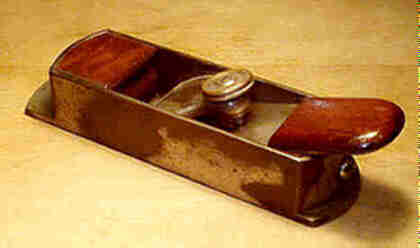

While the rest of America was hell-bent toward mass production of better mousetraps, there existed a practically clandestine fraternity of fine toolmakers in New York City. These makers supplied many of the Old World artisans, fresh off the boat and Ellis Island, who had hopes of the good life that America offered to each and every immigrant who stepped onto these shores. Among the most notable of these toolmakers is the father-son tag team of Napolean and Julius Erlandsen, who both made fine tools, mostly planes (mitre, shoulder, and rabbet), during the latter part of the 19th century to the first quarter of the 20th.
Their mitre planes, such as that pictured here, are characterised by the mahogany pad that's screwed to the heel of the iron to offer greater comfort during use. The Erlandsens didn't adopt the costly manufacturing procedure of dovetailing the sides of the tool to the sole, but instead cast it from iron. They relied upon proper annealing and precision machinig (Napolean was a machnist by trade) to make this tool nearly as fine as their competition operating in Great Britain. The sole, ahead of the iron, is a separate piece, which makes it easier to cut the ultra-fine mouth that's prerequisite on this class of tool.
Like many of their contemporary toolmakers, the Erlandsens used the finer grades of wood only where it is visible on the tool, with common junk woods where they aren't seen. In this case, the stuffing at the toe of the plane has pine blocks beneath the fine mahogany. Even back then, when fine wood was much more plentiful than it is today, conservation and frugality were being practiced on the finest tools.
This plane is nickel plated, and the workman's fingers have worn that away leaving a pattern that indicate exactly how he held the tool, forever linking him to the present and future owners of this fine tool.
Copyright (c) 1998-2012 by Patrick A. Leach. All Rights Reserved. No part may be reproduced by any means without the written permission from the author.